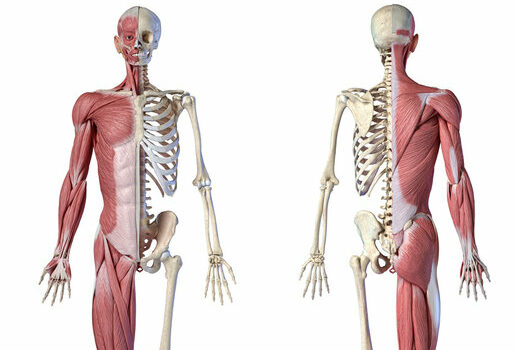
Musculoskeletal System
The musculoskeletal system encompasses all of the bones, cartilage, ligaments, tendons, and connective tissues in the body. The skeleton holds together the muscles and soft tissues, collectively functioning to support the body’s weight, maintain posture, and facilitate movement.
General Overview of the Skeletal System
Functions
- Support
- Protection
- Movement
- Storage
- Minerals
- Ca+ – used in many processes in body
- Must be maintained at certain levels in blood
- Marrow
- Haematopoietic stem cells
- Fat
- Minerals
- Blood Production – Haematopoiesis
Metabolism of bone & its hormonal control
- Calcitonin → Ca+ salt deposit in bone
- Parathyroid hormone → resorption of Ca+ from bone by osteoclasts → increases blood Ca+ levels
- Estrogen → restrains osteoclast activity & promotes deposition of new bone
Osteoporosis
- Bone resorption outstrips deposition → bone density decreases – risk of fractures increases
- Cancellous bone is affected first having a quicker turnover (remodeling rate)
- Trabeculae become porous & lighter or even disappear
- Common in postmenopausal women: reduced levels of estrogen → increased osteoclast activity
Bone composition
- Organic
- Collagen & other proteins
- 35%
- Flexibility
- Tensile strength
- Inorganic
- Mineral salts
- 65%
- Compression strength
- Reason why bone preserves well
Bone & associated tissue histology
Bone
- Compact bone
- Thicker, denser
- Comprised of osteons, the basic units of compact bone
- Haversian canal
- Blood vessels
- Nerve fibers
- Lamellae
- Rings of collagen fibers surrounding Haversian canals
- Collagen fibers oppose each other diagonally
- Resists torsional stress
- Lacunae
- Tiny caverns between lamellae
- Residences of the osteocytes
- Canaliculi
- Tiny plasma membrane extensions of the osteocytes
- Allows communication between osteocytes
- Allows nutrient sharing between osteocytes
- Haversian canal
- Cancellous bone (spongy)
- Trabeculae (struts) relay stress to the dense compact bone
- Houses marrow in between trabeculae
- Blood vessels
- Osteoblasts
- Fat cells
Cartilage
- Avascular
- Chondrocytes in columns in lacunae
- Ground substances: fiber + H2O
Bone Development
Intramembranous Bone Formation
- Ossification within membranes
- Cranial bones of the skull
- Clavicles
Endochondral Bone Formation
- From cartilage
- Hyaline cartilage
- Primary ossification center in diaphysis
- Secondary ossification center in epiphyses
- Epiphyseal plate (growth plate)
- 5 Phases
- Phase 1 & 2
- In utero
- Hyaline cartilage template
- Osteoblasts begin depositing bone
- Bone collar forms around diaphysis
- Cartilage cells in center die – leaves cavity
- 1O Ossification center forms
- Phase 3
- In utero
- Blood vessels penetrate into center cavity
- Fibroblasts enter through blood
- Fibroblasts convert to osteoblasts
- Spongy bone forms along shaft
- Phase 4
- At birth
- Elongation of diaphysis
- 2O Ossification center forms in epiphysis
- Medullary (marrow) cavity forms
- Phase 5
- Growth & maturation
- Complete ossification of epiphyses
- Hyaline cartilage remains at
- Epiphyseal (growth) plate
- Articular surface
- Phase 1 & 2
Bone remodeling
- Bone is living tissue
- Requires blood supply & constant remodeling
- Bone remodels in response to
- Calcium requirements in body
- Mechanical stress
Resorption
Destruction of old bone matter by osteoclasts
- Large multinucleated cells
- Plasma membrane attaches to bone
- Forms a seal
- Secretes enzymes (collagenase), acid, & lysosomes
- Creates a recess (Howship’s Lacunae)
- Bone matrix at site gets eroded
- Endocytoses digested material
- Packages digested material
- Exocytoses digested material into extracellular matrix
- Material taken away by blood
Apposition
Deposition of new bone matter by osteoblasts
- Large golgi – cells of high protein & proteoglycan synthesis
- Secrete osteoid (unmineralised organic bone matrix) into lacunae
- Osteoid + mineralization = mature bone
- Osteoblasts trapped in matrix become osteocytes when bone formation has ceased
Example: Long bone growth
- Length
- Apposition at epiphyseal line
- By osteoblasts
- Width
- Apposition by osteoblasts
- Resorption (bone removal) by osteoclasts
Classification of bones
Long
- Humerus
- Femur
Short
- Carpals
- Tarsals
Flat
- Sternum
- Scapula
Irregular
- Vertebra
- Innominate bones (ossa coxae)
Sesamoid
- Patella
- Other bones inside tendons → can occur in tendons of the big toe
We are working very hard to update the rest of this article – check back soon!
In the meantime, feel free to explore our other resources and start the search for your dream job here.
